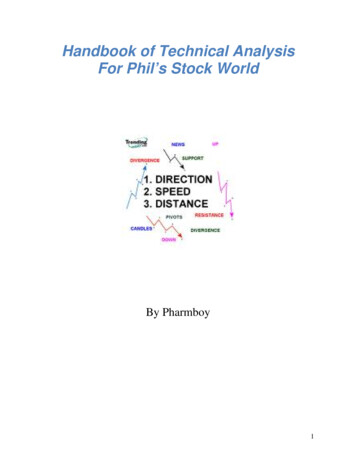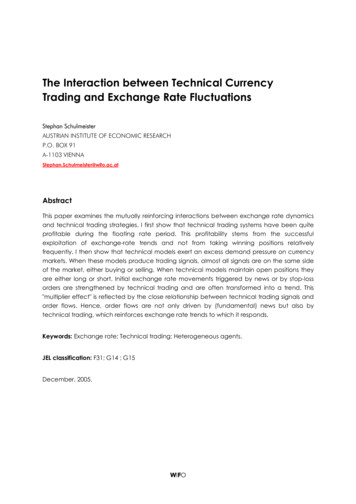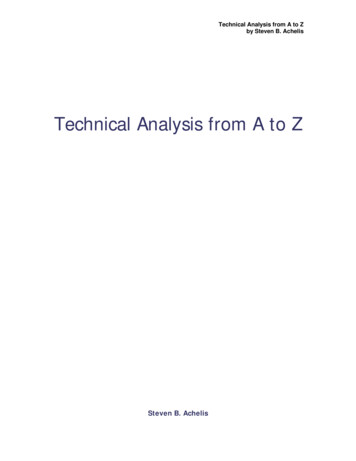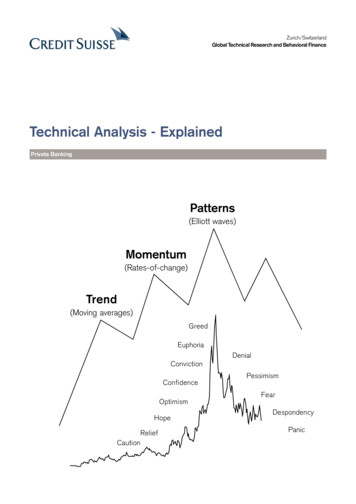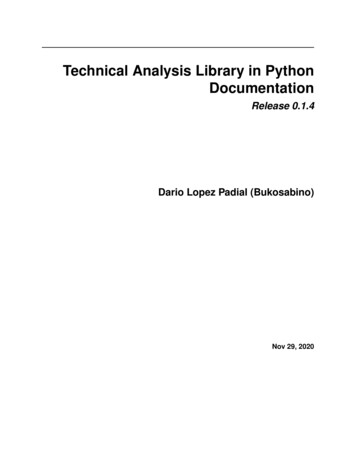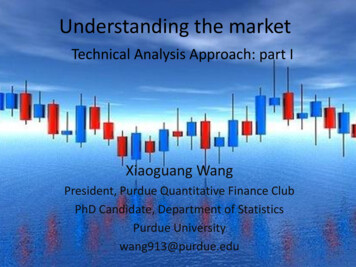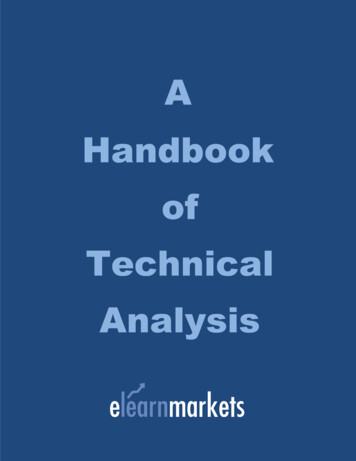
Transcription
AHandbookofTechnicalAnalysis
A HANDBOOK OF TECHNICALANALYSISCONTENTSIntroduction3CHAPTER - 15Types of Charts51.1 : Line Charts:61.2 : Bar Charts:71.3 : Candlestick Chart:7CHAPTER - 29Trends92.1 : Market Trend and Range-Bound Consolidation:102.2 : Trendline & Channels:122.3 Role Reversal:142.4 : Channels14CHAPTER - 316Volume16CHAPTER- 419Classical Chart patterns194.1 : Head and Shoulder & Inverse Head & Shoulder:204.2 Double Tops and Bottoms:214.3 : Triple Tops and Bottoms:224.4 Triangles:234.5 : Flag and Pennant:244.6 Wedge:25CHAPTER – 526Candlestick Reversal Patterns265.1 : Hammer:275.2 : Shooting Star:285.3 : Inverted-Hammer:305.4 : Hanging Man:305.5 : Bullish Engulfing Pattern:315.6 : Bearish Engulfing Pattern:321 Page
A HANDBOOK OF TECHNICALANALYSIS5.7 : Piercing Pattern:325.8 : Dark Cloud Cover:335.9: Doji:33CHAPTER - 635Indicators356.1: Simple Moving Average:366.2: RSI:376.2.1 : Calculation:386.2.2 : Usage:386.3: ADX:38Conclusion40About Us42Elearnmarkets432 Page
A HANDBOOK OF TECHNICALANALYSISIntroduction3 Page
A HANDBOOK OF TECHNICALANALYSISIntroduction:Market analysis is broadly categorized into two main methods, the first one isfundamental analysis and the second one is technical analysis. In fundamental analysisan analyst needs to look at the financial statements of a company, its business model,overall macroeconomic scenarios, management capabilities and many more things forcoming to a specific fair value of a company. On the contrary the discipline of technicalanalysis is not at all concerned with this detailed study of fundamental factors. On thecontrary, a technical analyst only looks at price of a stock derived as a result of supplydemand interaction. For a technical analysts’ price is supreme and he or she sees priceas manifestation of every fundamental reality. Hence, they look only at two mainaspects in the market. Price -over -time and volume.The entire discipline of technical analysis is based on these two data points, price overtime and volume. All patterns, indicators, concepts are derived from these two basic datapoints. Technical analysis is a very interesting subject. This is not a definitive science,rather a probabilistic discipline. In simple terms, it is more of an art than science. Thereare well known chart patterns or indicators in the market. But nothing works 100% oftime. We still follow them because they work more number of times than they fail. Henceemerged the concept of probability, the number of times anything works among thenumber of times that occur. This ratio is different in different stocks in different phases.That is why it is called an art. With experience, a chartist is able to form an opinion of hisor her own so that he has some extra edge on the market assessment than someonehaving just bookish knowledge of technical analysis. This book on technical analysis isyour stepping stone towards the journey to become a seasoned technical analyst. Werequest you to go through the concept slowly one at a time and keep observing chartson regular basis. Look at old charts and also look at contemporary live charts. Once youfind a pattern or some indicator try to predict the future move and note down yourprediction. Then as time flows try to match the price action with your prediction. Thenanalyze why it worked or not worked. Make notes and progress with the e-book and thenotes. This a long journey and we wish you best of luck.4 Page
A HANDBOOK OF TECHNICALANALYSISCHAPTER - 1Types of Charts5 Page
A HANDBOOK OF TECHNICALANALYSISChapter 1: Types of ChartsCharts are two-dimensional representation of price over time. There are many types of chartsavailable. But most popular and widely used among them are Line Charts, Bar Charts and theCandlestick Charts. The X axis,i.e. the time axis is crucial. The unit can be month, week, day, hour, 5 min or few seconds. Theshorter the time period, more detailed the chart becomes. The beauty of time in technical analysis isthat the same concepts apply to charts irrespective of time-frame of observation. However, thesuccess rate of individual patterns or indicators-based decisions may vary across time frames.Generally higher the time frame of chart, relatively higher is the probability of any concept in market.1.1: Line Charts:In line chart each and every price point is represented as a dot. The X axis represents the time scaleand the Y axis represents the price. Each dot or point represents the closing price at the end of aunit of time. These points are then joined to form a line. This is the simplest form of chart. But this isquite good if we want to plot 3-4 similarly priced stocks in a single chart and compare. Moreover, theline chart gives the clearest idea about price direction of a stock.Figure 1.1: Line Chart6 Page
A HANDBOOK OF TECHNICALANALYSIS1.2: Bar Charts:A bar chart is comprised of a series of bars. Every bar has four important price points - open closehigh and low. The bars are represented in green or blue color when close is higher than open andred color when close is lower than open. The bar charts are more detailed than the line chart and aregood for demonstrating or spotting the classical price patterns. We will discuss about the classicalchart patterns in appropriate time.Figure 1.2: Bar Chart1.3: Candlestick Chart:The concept of candlestick charts came from Japan. That is why they are often referred to asJapanese candlestick charts. These charts are the most versatile and popular form of chartrepresentation. Price behavior during each time unit is represented in the form of a candle. If theclosing price of a stock is higher than open price during a particular time period, then the candle isgreen, if the close price is below the open price then the candle is red. Each candle has a body andtwo wicks. The distance between open to close is represented by the body of a candle and theupper and lower wicks represent the highs and lows of a candle.7 Page
A HANDBOOK OF TECHNICALANALYSISFigure 1. 3(a): Candlestick Chart Diagrammatic RepresentationCandlestick chart is special not only because it adds a special visual clarity about the priceaction, but also because often a single candle stick or two or three consecutive candlestickstogether form a pattern that indicate reversal of a prior move or give conviction on continuation ofthe ongoing move. These are called candlestick patterns. We will discuss about them in duecourse of time.Figure: 1.3(b): Candlestick Chart Pattern ExampleAfter getting introduced to the concept of charting we will discuss about the concept of trend.8 Page
A HANDBOOK OF TECHNICALANALYSISCHAPTER - 2Trends9 Page
A HANDBOOK OF TECHNICALANALYSISChapter 2: Trends2.1: Market Trend and Range-Bound Consolidation:Often market movements happen in the form of trends. A price trend is a continuous or adirectional price movement in upward or downward direction. We call them up -trend and down trend respectively. Now if we look at price action in market through charts, we will find that noprice movement happens in a straight line.Suppose we are looking at a broader uptrend represented as primary move, we may findintermediate corrections represented as secondary trend and minor counter moves among thesecondary moves represented as minor trend. This is how the market behaves generally in boththe up and the down trends.Figure: 2.1(a): Market TrendsOften an up- trend is represented in the form of a sequence of higher highs and higher lows.Similarly a downtrend is represented as a sequence of lower lows and lower highs. A trend is saidto reverse when the sequence is broken.10 P a g e
A HANDBOOK OF TECHNICALANALYSISFigure: 2.1(b): Trend ReversalWe should remember a simple point that market is not trending all the time. Often the marketconsolidates within a small range and goes nowhere. Then suddenly it can break on the upside ordownside.Figure 2.1(c): Market Consolidation11 P a g e
A HANDBOOK OF TECHNICALANALYSIS2.2: Trendline & Channels:Trendline and Channels are one of the most simple and useful tools in the market. During anuptrend, a trendline is formed by joining lowest points of periodic pull-backs, defined as secondarymoves in the previous section. The up-trend line has positive slope. To be precise we need two lowsto join to form a trendline during an up-move. This line is then extended in the upward direction; thethird move towards the trend-line is used to validate the trend line. If the trend line is not broken inthe pull back, then it is called trend-line validation. It is often observed that price pulls back towardsthe trend line and moves higher. In an uptrending market it is often easier to make money if onebuys near the trend line and sells higher. The more number of time the trend-line is validated, moreimportant it becomes. An upward trend line is said to be the area of support. The selling pressuremeets the buying pressure here and eventually overtime when buying pressure is higher than sellingpressure price sees an upward bounce.Figure 2.2(a): UptrendNow when one buys he or she is looking for the prices to move higher. But this may or may nothappen. Hence the investor should maintain a stop loss point below which he-or she should cut hisposition, i.e. book loss.When a trend line is broken, either the market may reverse the trend, continue the uptrend withlittle less force or just go sideways.12 P a g e
A HANDBOOK OF TECHNICALANALYSISFigure 2.2(b): Uptrend ReversalSimilarly, during a down-trend: a trendline is formed by joining pull-back highs. They slopedownwards. Just like an up-trend line a down-trend line is formed by joining two points and thenextended in downward direction. Pull backs towards the trend-lines are low risk points for short sellingwith a stop loss little above the trend line. More number of times the line is validated, more it grows inimportance.Figure: 2.2(c): DowntrendSimilar to an uptrend-line, when a down trending trend line is broken the trend may continue withless pace, or reverse or may go side-ways. A downward trend line is said to be area of resistance.13 P a g e
A HANDBOOK OF TECHNICALANALYSISThe selling pressure14 P a g e
A HANDBOOK OF TECHNICALANALYSISmeets the buying pressure here and eventually overtime when selling pressure is higher than buyingpressure price sees a decline.2.3 Role Reversal:Once a trendline support or resistance is broken, its role is reversed. If the price falls below a supportline, that line will become resistance. If the price rises above a resistance line, it will often becomesupport. As the price moves past a line of support or resistance, it is considered that supply anddemand have shifted, causing the breached line to reverse its role. For a true reversal to occur,however, it is important that the prices make a strong move through either the support or resistanceline.Figure 2.3: Role Reversal2.4: ChannelsThe concept of channel is much similar to trend lines. When in an uptrend or in a down trend orin a consolidation, we see rhythmic movement in form of parallelogram, we can draw channels.The channel boundaries are good points for reversal trades with small stop losses.15 P a g e
A HANDBOOK OF TECHNICALANALYSISFigure 2.4: ChannelsOnce price is out of the channel, the trend or range of the stock is broken.16 P a g e
A HANDBOOK OF TECHNICALANALYSISCHAPTER - 3Volume17 P a g e
A HANDBOOK OF TECHNICALANALYSISChapter 3: Volume:In this section we introduce the second aspect of charting. This is called volume. Traded volume isthe number of quantity of stocks which change hand. The volume is shown as a sub graph in theprice-time chart, below the price window. Higher the volume in any particular move, the greater is theconviction in that move to continue greater distance in that direction. However, if volume is on thelower side during a move, the stock is generally bound to lose momentum.Generally, during range bound phases, the volume is low.Figure 3: VolumeAn important point regarding volume is that traded volume in absolute term has nosignificance. When we talk about higher or lower volume, it is relative to average volume overcertain time periods.TrendVolumeInterpretationUpHighUptrend may go greater distanceUpLowLack of conviction/ participation in uptrend.Likely to retrace.18 P a g e
A HANDBOOK OF TECHNICALANALYSISDownHighDown move may cover greater distanceDownLowLess conviction in the down move, may reverseApart from traded volume, one important concept regarding volume is delivery %. In the market aperson can first buy shares and sell by the end of the day. He or she can do the reverse too. This iscalled intra-day trading. However, if an investor is having a positive view he may buy the share andcarry forward it for a number of days. This is called taking delivery of a share. Hence if there is aprice rise of a stock with high % of delivery volume, then this signifies a positive conviction in thestock. Similarly, if a lot of people are long term negative about a stock, they may sell the stock andgive delivery. Markets are driven by buyers and sellers.People who have positive view on a security are called bulls and people who have negative vieware called bears. The price of a security in a market is determined by supply-demand dynamics ofany stock. If the supply is high and a lot of people look to sell the stock, than there are availablebuyers, the price is likely to decline. Hence a fall in price with high delivery % is known asnegative for a stock.19 P a g e
A HANDBOOK OF TECHNICALANALYSISCHAPTER- 4ClassicalChart patterns20 P a g e
A HANDBOOK OF TECHNICALANALYSISChapter 4: Classical Chart Patterns:As we have discussed in the previous section, that market can be either in trending phase or in arange-bound phase. No trend generally lasts forever in the market. After prolonged or medium orshorter duration up and downtrend, the market often reverses and a move starts in the oppositedirection of the prior move. Often we find that well defined geometrical patterns are formed in thechart which provides good indication of price reversals. These patterns are called reversal classicalchart patterns. When they are formed as a bullish reversal pattern they are said to be part ofaccumulation. On the other hand if they are formed at the top of a price move just before bearishreversal, then they are part of distribution.However, a geometrically shaped consolidation does not necessarily mean price reversal. Often priceresumes the erstwhile trend post the consolidation move. These are called continuation classicalchart pattern. We will discuss about few of the classical chart patterns in the following section.4.1: Head and Shoulder & Inverse Head & Shoulder:Head and Shoulder pattern is a bearish reversal pattern. This pattern appears after an uptrend. Thispattern is formed with three consecutive tops with middle one being higher than the other two. Themiddle top is called the head and the two side peaks are called the shoulders. On joining theintermediate troughs, we get the neck-line. On ultimate break below the neckline, usually a shorttrade is taken with a stop-loss above the top of the nearest shoulder. The target is usuallyconsidered as the distance between the neckline and head, projected from the point of break. If thevolume in the down leg of the right shoulder is on the higher side and break happens with highvolume, the conviction is on the higher side for the reversal.21 P a g e
A HANDBOOK OF TECHNICALANALYSISFigure 4.1: Head and Shoulder PatternAn Inverse Head and Shoulder is just mirror image of the Head and Shoulder pattern. This shouldappear after a sustained down trend, the rule of stop loss and target are similar. This often actsas a very effective bullish reversal pattern.4.2 Double Tops and Bottoms:These chart patterns are well-known patterns that signal a trend reversal – these are considered tobe one of the most reliable patterns and are commonly used. These patterns are formed after asustained trend and signal to chartists that the trend is about to reverse. These patterns are createdwhen price movement tests support or resistance levels twice and is unable to break through. Thesepatterns are often used to signal intermediate and long-term trend reversals.Figure 4.2: Double Tops and Bottoms22 P a g e
A HANDBOOK OF TECHNICALANALYSIS4.3: Triple Tops and Bottoms:These are another set of reversal chart patterns in chart analysis. These are not as prevalent incharts as Head and Shoulders and Double Tops and Bottoms, but they act in a similar fashion.These two chart patterns are formed when the price movement tests a level of support or resistancethree times and is unable to break through. They signal a reversal of the prior trend. A trade entry isinitiated at the break of a neckline with a small stop-loss and the target is measured as the distancebetween peaks/troughs and the neckline.Figure 4.3: Triple Tops and Bottoms23 P a g e
A HANDBOOK OF TECHNICALANALYSIS4.4 Triangles:Triangles are one of the most well-known chart patterns used in technical analysis. The three mostcommon types of triangles, which vary in construction and implications, are Symmetrical Triangle,Ascending Triangle and Descending Triangle. These chart patterns are considered to last anywherefrom a couple of weeks (ideally more than 12 weeks) to several months. These are areas ofconsolidations after a trending move and are generally continuation patterns, i.e. the erstwhile trendsresumes after the breakout. However, in certain cases they act as reversal patterns. They can appearboth in up-trend and down-trend.Figure 4.4: Three Kinds of Triangle Patterns24 P a g e
A HANDBOOK OF TECHNICALANALYSIS4.5: Flag and Pennant:These two short-term chart patterns are continuation patterns that are formed when there is a sharpprice movement followed by a generally sideways price movement. The patterns are generallythought to last from one to three weeks (Can last from 1 to 12 week but ideally they should lastbetween 1 and 4 weeks). They can appear both in up-trend and down-trend.Figure 4.5: Flags and Pennants25 P a g e
A HANDBOOK OF TECHNICALANALYSIS4.6 Wedge:The Wedge chart pattern can be either a continuation or reversal pattern. It is similar to a SymmetricalTriangle except that the Wedge Pattern slants in an upward or downward direction, while thesymmetrical triangle generally shows a sideways movement. The other difference is that Wedgestend to form over longer periods, usually between three and six months. The fact that Wedges areclassified as both continuation and reversal patterns, can make reading signals confusing. However,at the most basic level, a falling wedge in an uptrend is bullish and a rising wedge in a downtrend isconsidered bearish.Figure4.6: Wedges26 P a g e
A HANDBOOK OF TECHNICALANALYSISCHAPTER – 5CandlestickReversalPatterns27 P a g e
A HANDBOOK OF TECHNICALANALYSISChapter 5: Candlestick Reversal PatternsWhen we had discussed about the candlestick charts, we had said that they have an edge overmany other types of charts representation due to recognizable chart patterns which are easy todefine and which work beautifully in the market.In this section we will discuss about few chart popular candlestick patterns. Candlestick patternsprovide entry and stop-loss criteria, but there are no target setup as available in classical chartpatterns.5.1: Hammer:Hammer is a single candlestick bullish reversal pattern. This occurs after a prolonged down trend.Ideally there should be a gap down opening and bears should be able to push the price lower as acontinuation of a down- move. At this point, bulls should overpower bears and push price higher andmake close near to the opening price. The candle formed in this process should be having a smallbody, a big lower shadow and a negligibly small upper shadow. Ideally the lower shadow should beat least twice the length of the body. The color of the body can be either green or red, but if the bodycolor is green, then the hammer is considered a little more bullish, as the bulls were strong enoughto close the price higher than the open price. The next day or in next two three days, ideally thereshould be a gap up opening or price should move above the high of the hammer candle. This iscalled confirmation or validation of the pattern. A hammer like candle, without validation has no realsignificance. If price moves above the high of the hammer a buy trade can be taken with a stop lossbelow the low of the candle.Figure 5.1(a): Hammer28 P a g e
A HANDBOOK OF TECHNICALANALYSISFigure 5.1(b): Hammer Example5.2: Shooting Star:A shooting star is just like a mirror image of a hammer candle. First there should be a sustained uptrend and then there has to be a gap up opening. The bulls should push price higher in the initial partof the day. Then, later in the day bears should take in the control of the stock and push prices down.Eventually the closing price should be very close to the opening price, resulting in a candle with asmall green or red body, a big upper shadow and a small or negligible lower shadow. The uppershadow of the candle should be at least twice the length of the body. Now a confirmation of theshooting star pattern comes if price moves below the low of the candle within next 2-3 candles. Onconfirmation, a short trade should be taken with stop loss above the high of the high of the candle. Ashooting star pattern with a red body is considered slightly more bearish than one with a green body.It is often observed that shooting star candlestick pattern acts as bearish reversal pattern andtriggers a down move after an uptrend.29 P a g e
A HANDBOOK OF TECHNICALANALYSISFigure 5.2(a): Shooting StarStop LossConfirmationFigure 5.2(b) Shooting Star Example:30 P a g e
A HANDBOOK OF TECHNICALANALYSIS5.3: Inverted-Hammer:An inverted hammer is a single candlestick bullish reversal pattern. The pattern appears after asustained down-trend. At the beginning of the day there should be a gap-down opening. However,bulls should push the price higher during the course of the day. Eventually the bears should push theprice lower during the course of the day and close near the open price. The resulting candle shouldhave a small body, red or green, the upper wick should be at least twice the body of the candle andthe lower shadow should be quite small or negligible in size. If the body is green it is relatively bullishthan if it is red. This looks like an inverted hammer as the name suggests. The philosophy is thatbears were not able to push the price below the opening price during the course of the day. Thispattern, however, is considered to be little less bullish than the hammer itself, because in hammerbulls are able to force a higher close by the end of the day. The confirmation of the pattern comesonce the price moves above the high of the candle. On confirmation a buy trade can be initiated witha stop loss below the low of the candle. Inverted hammer occurs little less frequently in market ascompared to hammer pattern.Figure 5.3: Inverted Hammer5.4: Hanging Man:Hanging Man is a single candlestick bearish reversal pattern. This appears after a sustained upmove. The candle looks like a hammer; only difference is that it appears at the end of an up-trend. Thecandle should have a small body at the top (red/green) and a lower shadow at least twice the lengthof the body. There should be very small or no upper shadow. A red colored body of hanging manpattern is more bearish than a hanging man pattern with green body. The confirmation of the patternhappens when price moves below the low of the candle. On confirmation a trader may take shorttrade with stop-loss above the high of the candle. The hanging man pattern is bearish counterpart ofBullish inverted hammer. However this appears much less frequently than shooting star which isanother bearish reversal pattern.31 P a g e
A HANDBOOK OF TECHNICALANALYSISFigure 5.4: Hanging Man Pattern5.5: Bullish Engulfing Pattern:Bullish candlestick pattern is a two-candlestick bullish reversal pattern. First there should be adowntrend. Then we should have a red candle followed by a green candle. The body of the greencandle should engulf the body of the first red candle. The idea is in the second candle thatconstitutes the pattern, the day started below the previous day’s close on a bearish note. However,as the day progresses, the bulls take-over the charge and eventually succeed to close aboveprevious day’s high. In such a scenario, if the highest point of these two candlesticks is breached onthe upside within next 2-3 candles, the bearish engulfing pattern is said to be confirmed. A buy tradecan be initiated upon confirmation with stop-loss below the low of the two candlestick patterns.Figure 5.5: Bullish Engulfing Pattern32 P a g e
A HANDBOOK OF TECHNICALANALYSIS5.6: Bearish Engulfing Pattern:Bearish Engulfing pattern is just mirror image of bullish engulfing pattern with bearish implication.First, we should be having an up-trend. Then we should have a green candle as continuation. Thenext day should see a gap up above the close of previous day. The 2nd day candle shouldeventually close red with its body totally engulfing the body of the first candle. The confirmationcomes when within next 2-3 candles the price moves below the low of the two candles forming theBearish Engulfing pattern. On confirmation a trader may take a short trade with stop loss above thetop of the two candlestick patterns. Larger the 2nd candle, more bearish is the pattern.Figure 5.6: Bearish Engulfing Pattern5.7: Piercing Pattern:The piercing pattern is just similar to the bullish engulfing pattern; only thing is that the 2nd candle inthe two candlestick pattern does not close engulfing the body of the first candle. Instead it closescrossing the halfway mark of the body of the first candle. A confirmation comes when price crossesthe high of the two candlestick patterns within next 2-3 candles. On confirmation one may take a buytrade with stop loss below the low of the candle.33 P a g e
A HANDBOOK OF TECHNICALANALYSISFigure 5.7: Piercing Pattern5.8: Dark Cloud Cover:The Dark cloud cover is a two candlestick bearish reversal pattern and much similar to the bearishengulfing pattern. In this pattern, the second candle, unlike the bearish engulfing pattern falls short ofengulfing the first candle, instead it crosses 50% the body of the first candle. The confirmationcomes when a candle breaches the bottom of the pattern. On confirmation a short trade can betaken with stop loss above the high of the candle.Figure 5.8: Dark Cloud Cover5.9: Doji:The Doji is a single candlestick pattern. The Doji assumes significance, when it appears after atrending move, be it up or down. The Doji symbolizes indecision and after a Doji the incumbenttrend can reverse, go34 P a g e
A HANDBOOK OF TECHNICALANALYSISsideways or continue uptrend. However, appearance of a Doji is a signal of caution that theprobability is high that the erstwhile trend may be coming to an end. Doji is a candle which has openand close almost at similar level. There can be upper shadows and lower shadows of variousproportions.Figure 5.9: Doji35 P a g e
A HANDBOOK OF TECHNICALANALYSISCHAPTER - 6Indicators36 P a g e
A HANDBOOK OF TECHNICALANALYSISChapter 6: IndicatorsIndicators are tools to aid decision making in the market. There are various types of indicators whichmeasures or indicate the trend, the momentum, the volatility and various other aspects in themarket. There are thousands of indicators which are derived out of the price and volume data overtime. Here we introduce you with four very useful indicators.6.1: Simple Moving Average:Simple Moving Average or SMA is a moving average which is calculated by adding the closing priceof security prices for the last n-periods and dividing it by the total number of time periods.For example, suppose we want to calculate the 9 periods SMA of a security price.First, we will add the last 9 Days Closing Price of the security and then it will be divided by the 9periods. Calculation for 9 periods SMA:(P9 P8 P7 P6 . P1)/9Where,P PriceP9 Closing Price 9 days agoSMA is a Technical indicator which is represented by a line and it is directly plotted on the securityprice. As per the choice of the trader, the periods can be changed in the SMA indicator.For shorter-term SMA, we can use 5,8,13 etc. For Medium term 20, 34, 50 and for longer term100,200 can be used.37 P a g e
A HANDBOOK OF TECHNICALANALYSISIf a medium term moving average is having a positive slope, the trend is considered to be positive inmedium term and vice versa.Price breaching a particular moving average from down to up is considered a bullish sign.Similarly, price breaching a particular moving average from upside and closing below isconsidered bearish.If we find a shorter term moving average crossing a medium term moving average from below,often this is called bullish crossover. On the other hand if a shorter term moving average crosses amedium term moving average from upside to below that is called a bearish crossover and oftenconsidered a signal of bearishness.Figure 6.1: Simple Moving Average6.2: RSI:Relative Strength Index (RSI) is a momentum oscillator, developed by J. Welles Wilder, whichmeasures the speed and velocity of price movement of trading instruments (stocks, commodityfutures, bonds, forex etc.) over a specified period of time.The objective of RSI indicator is to measure the change in price momentum. It is a leadingindicator and is widely used by Technical Analysts over the globe. RSI can be used to spot ageneral trend. It is considered overbought when it goes above 70 and oversold when it goes below30. 30-70 region of RSI is considered to be normal zone.38 P a g e
A
A HANDBOOK OF TECHNICAL ANALYSIS 1 P a g e CONTENTS Introduction 3 CHAPTER - 1 5 Types of Charts 5 1.1 : Line Charts: 6 1.2 : Bar Charts: 7 1.3 : Candlestick Chart: 7 CHAPTER - 2 9 Trends 9 2.1 : Market Trend and Range-Bound Consolidation: 10 2.2 : Trendline & Channels: 12 2.3 Role Reversal: 14
